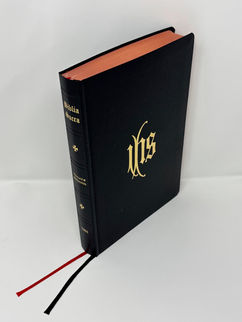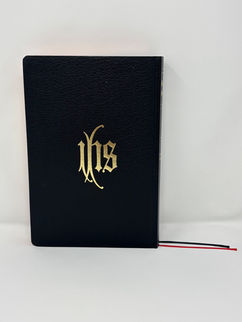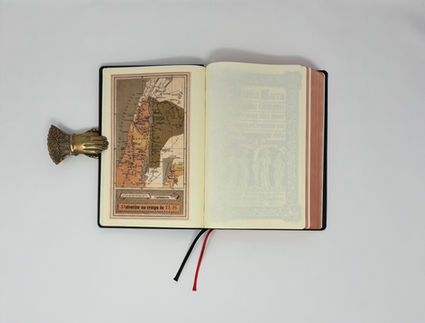BIBLIA SACRA
Vulgatae Editionis
The Latin Vulgate Bible according to the "Clementine" edition
Originally typeset and illustrated by Desclee, Lefebvre, & Assoc. under the Society of St. John the Evangelist in 1901 A.D.
Reprinted by Church Latin Publishing Co. in 2021 A.D.
Note: All three editions have the same content and differ only in materials and construction.
Enhanced Edition - $99.99 USD
Sewn binding, red pages edges, ribbon markers, flexible imitation leather cover.
Hardcover Edition - $64.99 USD
Glued binding, ribbon markers, matte laminated hardcover.
Softcover Edition - $44.99 USD
Glued binding, matte laminated softcover.
After many years of anticipation, I am proud to be offering a reprint of the magnificent Latin Vulgate Bible published by the Society of St. John the Evangelist, 120 years ago. These Vulgate bibles are a true icon of Catholic history and can be described as a "modern adaptation of a medieval manuscript." This reprint of the Latin Vulgate Bible is both a testimony to Catholic Tradition and a living archive of Catholic scriptural legacy. It also pays homage to the authority of the Clementine text and is a tribute to the lost art of more elegant religious and liturgical typesetting and printing.
An excerpt from the "Editor to the Reader" of this bible perfectly summarizes both the reasons it was originally published and why we have labored to bring it back into print.
"May, finally, this edition of the Sacred Bible be published, and may it bear exceedingly rich fruits of knowledge and piety; we humbly pray that St. John the Evangelist, our great patron, who drew his stream of divine eloquence from the sacred font itself of the Lord’s breast and, inebriated with the grace of the Holy Ghost, more deeply revealed to others the hidden things of Divinity, might obtain these results for us through his kind intercession with the most sacred Heart of Jesus."
Features
-
Complete text of the Latin Vulgate Bible, Old and New Testaments
-
Includes "extra-canonical" books of the Old Testament
-
Prayer of Manasseh
-
3rd and 4th Books of Esdras
-
14th chapter of Daniel known as the 'Bel and Dragon'
-
-
Entirely in Latin
-
Text edited according to the Vatican Edition of the Clementine Vulgate of 1598 A.D.
-
Fully cross referenced between Old and New Testaments and vice versa
-
Chapter headings
-
Engravings that illustrate biblical scenes at the beginning of many books of the bible
-
Text is arranged for excellent readability and typeset in a beautiful Elzevirian font (@ 7.5 pts)
Specifications
-
Exact facsimile of original, true to the original with no additions/subtractions
-
Minor corrections were done to improve legibility)
-
Flexible black Skivertex covers with gold foil debossing (Enhanced Edition)
-
6" wide X 9" tall pages
-
External dimensions: 6 1/4" wide X 9 1/4" tall X 1" thick
-
988 total pages
-
Paper: Premium 40 GSM cream bible paper (Enhanced edition)
-
Paper: 40 lb off white (Hardcover and softcover editions)
-
Font size: Approximately 7.5 pts
-
2 color maps located on the front and back end sheets
-
Colored headbands
-
2 ribbon markers
-
Printed and bound in the Netherlands (Enhanced edition)
-
Printed and bound in the USA (Hardcover and Softcover editions)
-
ISBN 979-8-9899928-3-6
Contents
-
Map of Palestine, at the time of Our Savior
-
Front matter:
-
Title page
-
Imprimatur
-
A note to the reader
-
Preface to the Vatican edition of the Vulgate 1592 AD
-
Decree concerning the canonical scriptures, from the Council of Trent - fourth session,
-
-
Remembrance of Pope Clement the 8th.
-
Prefaces of St. Jerome (28 pages)
-
Table of Contents
-
Old Testament (694 pages)
-
New Testament (186 pages)
-
"Extra-canonical" books of the Old Testament (24 pages)
-
Prayer of Manassseh
-
3rd and 4th Books of Ezra
-
-
Index of Testimonies of Christ and the Apostles
-
Interpretation of Biblical Names
-
Index to the Bible
-
Index of Epistle and Gospel readings used in the Roman Missal
-
Publisher's information and an English translation of the "Note to the Reader"
-
Map of the travels of St. Paul
Sample pages are shown below
Frequently Asked Questions
Question:
Was this edition of the Holy Bible published with Ecclesiastical approval? What about Canon 825?
Canon 825: "Books of the sacred scriptures cannot be published unless the Apostolic See or the conference of bishops has approved them. For the publication of their translations into the vernacular, it is also required that they be approved by the same authority and provided with necessary and sufficient annotations."
Answer:
This edition was granted an Imprimatur in 1901 by ✠Most Reverend Carolus Gustavus Walravens, Bishop of Tournai, Belgium. Unless an Imprimatur is revoked by a succeeding Bishop or other Church authority, it remains in force. This is an exact facsimile reprint with no alterations. (thus eliminating the need for any further approval according to my understanding)
Also, to add a bit of weight to the authority of the text- the editors created this edition according to the 1598 edition of the Clementine Vulgate, which is a papally approved corrected edition of the 1592 Sixto-Clementine Vulgate promulgated by Pope Clement the VII. They also consulted the work of eminent biblical scholar Carolus Vercellone (specifically, his 1861 edition of Biblia Sacra) The reader can be assured that reliable sources were used to create this edition.
Question:
What about Canon 829: "The approval or permission to publish some work is valid for the original text but not for new editions or translations of the same." ?
Answer:
I am offering an "original text" (an exact, facsimile reprint), not a new edition or translation. To be called a "new edition" the text must undergo significant change.
Question:
Why is it that whenever Holy Scripture is used in the Roman Missal (Missale Romanum, 1962), the Latin text often differs from the Latin Vulgate? (specifically- the Clementine Version)
Answer:
My first assumption is that since the organic growth of liturgical texts started long before the promulgation of the Clementine Vulgate- the scriptural parts of the Missal were taken from Latin texts that existed at the time of its development (ie. the "Old Latin" Version which is primarily derived from the writings of the Church Fathers) While this is correct, it does not explain why the Church did not conform the missal to the Clementine text after it was promulgated in 1592.
While reading an excellent book by Mr. Timothy Flanders- "Introduction to the Holy Bible for Traditional Catholics", this question was laid to rest. He provides a short explanation of the relationship between the scriptural text of the Missal and that of the Vulgate. (you can read an excerpt from the book at this link, permission provided by the author)
I want to take this opportunity to promote Tim's book which I have read cover to cover. It is an excellent book that sheds light on many areas of Scriptural Tradition that I am particularly interested in.
I would also like to recommend a video that Tim did via his "Meaning of Catholic" channel on Youtube. It is all about the authority of the Vulgate and its prevalence in the history of the Church. LINK to video
Question:
What about textual integrity? What is the lineage of the Latin text of this bible? What were the sources used by the editors?
Answer:
The editors of this bible attempted to create a text which is both faithful to the Vatican edition of 1598 but also bears fruit from more recent scholarship. I hope to demonstrate this using the three examples below. (each image can be clicked on to open a full page PDF). The goal of the editors as stated in the note to the reader "...there might be a new edition in more elegant form which, while based on his [Carolus Vercellone] outstanding scriptural studies, could be produced at a lesser price,"
Let us look at the first 10 verses of the Gospel of John.



Starting on the left is the Vatican edition of the Clementine text printed in 1598. This is the last corrected edition of the original 1592 text. A few notable textual characteristics are the replacement of the word "et" with an ampersand and the truncation of some words- Reference the second occurrence of the word "verbum" in verse one. It is printed as "verbū". My guess is this method of abbreviation was used to decrease the length of the line so that the desired words would still fit in the desired space. One more observation is the lack of capitalization of the word "in" in verse 4.
Moving to the middle is the text of Carolus Vercellone. His fidelity to the 1598 edition is apparent. Only changing very minor textual anomalies such as capitalization and punctuation when needed. The addition of the chapter introductions are very helpful, which the 1901 edition retains.
On the right is the 1901 edition of the Society of St. John the Evangelist. The text benefits from Vercellone's corrections, while maintaining fidelity to the Vatican edition, and at the same time providing a very aesthetically pleasing and readable text with the bonus of illustrations and various appendices to further aid the reader. Upon a closer look, the 1901 edition is -in essence- a re-typesetting of the work of Carolus Vercellone's edition of 1861.
In my opinion, the 1901 edition could be one of the best texts of the Clementine Vulgate ever put into print.
Below are images of the Original Copy.
If you are interested in a 'behind the scenes' look of this reprint, click below for a detailed explanation of the process of bringing a book such as this back into print.
BIBLIA SACRA 1901 REPRINT- HOW IT WAS MADE
Please visit my Desclee Vulgate page for detailed information and history on this particular edition of the Latin Vulgate Bible.
Also, I've attempted to chronicle my progress on this project- which I began thinking about way back in 2008.
Professional Reviews
(The reviews below are for the hardcover edition)
Payments, Shipping, and Options
Vintage Gift Wrap option is available for the enhanced edition.
Click HERE for details.
The Bibles and books that are in stock and typically shipped within 24 hours of ordering.
All Major Credit Cards are Accepted, as is PayPal.
Shipping Information
Standard Domestic - One copy is shipped to your mailing address via trackable UPS Media Mail is $5.
USPS Priority Mail - One copy shipped in a USPS Priority Mail Medium Flat Rate Box is $15.
Contact for a quote on shipment of multiple quantities.
Shipment can be made to your physical address via UPS upon request, though this is not an option available at checkout. Contact for pricing.
International Orders - Please visit the information page HERE regarding international orders.
























